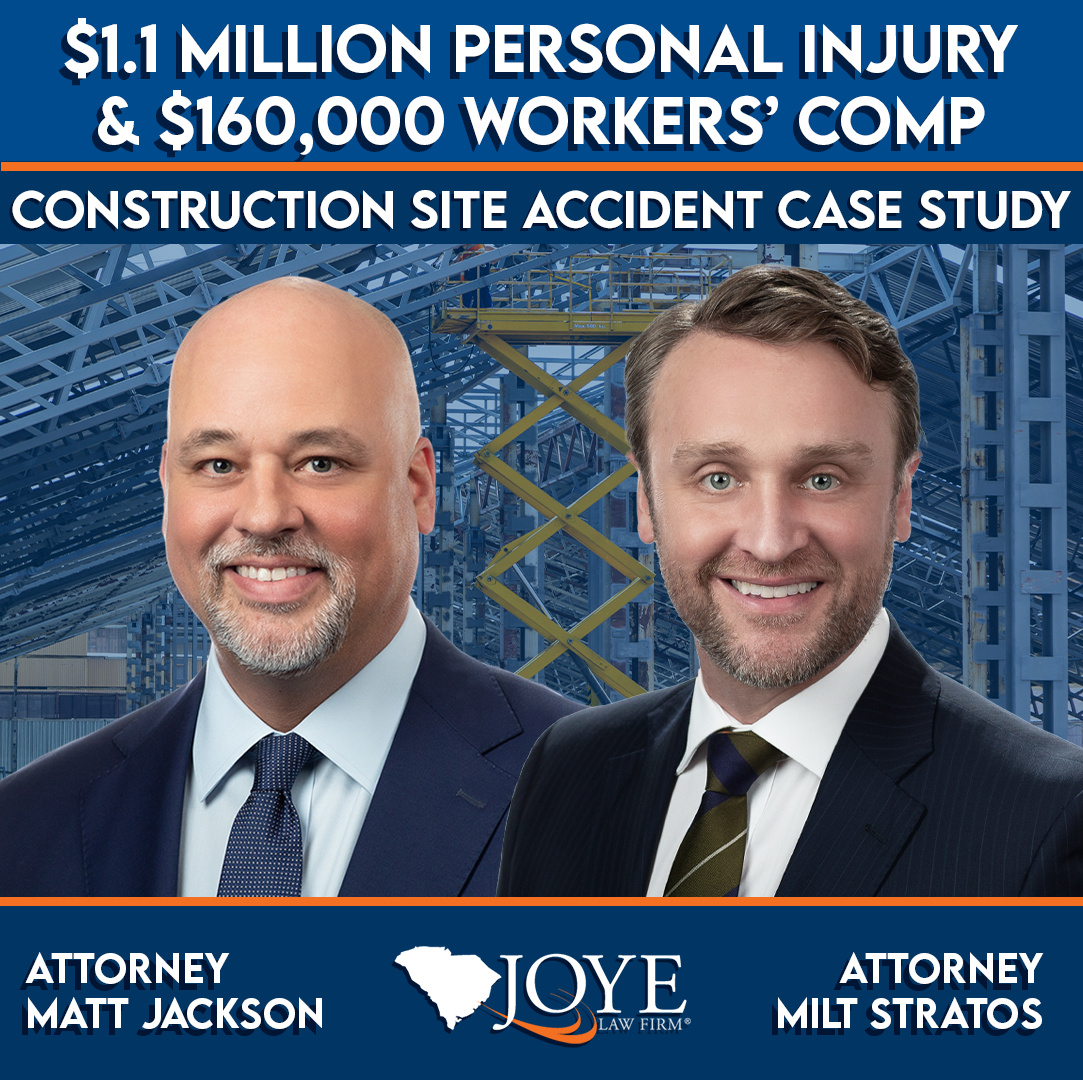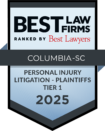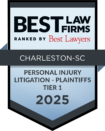
After dedicating years to raising her children, Diane* decided it was time to pursue her own career goals. Determined to create a brighter future, she returned to high school and proudly graduated alongside her youngest child. Armed with her diploma and newfound confidence, she launched a promising career as an Insulator apprentice in the construction industry. However, just three years into her apprenticeship, her aspirations were abruptly derailed by a preventable construction site accident.
In this case study, we will walk you through the progression of Diane’s case from start to finish, in hopes that her story can help someone else who finds themselves in a similar situation.
Accident Involving Scissor Lift on Job Site
On the day of the accident, Diane was working at the new Google Data Center in Moncks Corner. She was excited to be in the field working on such a big project. As she walked across the floor of the job site, a contractor for another company was installing an electrical conduit in the ceiling of the structure using a scissor lift.
The scissor lift operator made a lapse in judgment with grave consequences. Instead of operating the scissor lift from the inside of the lift, he removed the control panel to operate it. This maneuver is known as “walking the dog” and is not permitted as it vastly obstructs the user’s view from 360 degrees to only 180 degrees. As the operator moved the lift, Diane was walking by, and he drove it directly into her. The impact caused her to crash onto the concrete floor, landing hard on her right side.
Shoulder and Spine Injuries
After her fall she was seen by an urgent care doctor who noted injuries to her right shoulder, right knee, and cervical spine. A few days later she was seen again due to ongoing pain and limited ability to move or grip with her hands.
Subsequent MRIs revealed significant injuries to her right shoulder and cervical spine. Despite six months of physical therapy and receiving injections, her condition did not improve. Ultimately her injuries required arthroscopic surgery in January 2020 to repair her shoulder.
Workers’ Comp Case Begins
When Diane came to Joye Law Firm, five months after the incident, she was doing her best to recover from her injuries while trying to keep her job. However, her pain and mobility issues were worsening, making daily tasks increasingly difficult. Attorney Matt Jackson and Case Manager Deana Nash took on Diane’s workers’ compensation case.
Unfortunately, even after the surgery, Diane continued to experience pain and limited mobility. A vocational assessment later determined she could no longer perform basic tasks like lifting a gallon of milk or raising her arm above 45 degrees without severe pain. She also suffered from chronic headaches, tension in her neck, and an inability to sit for extended periods. By the end of 2020, Diane was unable to work and was determined to be disabled.
“In workers’ compensation claims, it’s not uncommon for an initial injury to later prove more severe or to impact other areas of the body due to aggravation or the interconnected nature of human anatomy,” explains Attorney Jackson. This was true for Diane. After her shoulder surgery failed to resolve her symptoms, attention turned to her neck.
Drawing on his experience with similar cases, Attorney Jackson recognized that her journey toward recovery wasn’t over. He referred her to an orthopedic surgeon, who identified significant disc issues that required another surgery.
Workers’ Compensation Negotiations and Settlement
Suffering an injury alone is not sufficient to qualify for workers’ compensation. The injury must also be directly linked to the employee’s job or a workplace accident. In Diane’s case, the defense doctor argued that her neck issues were unrelated to her original injury. However, while reviewing the case, Attorney Jackson discovered the defense doctor’s opinion was based on the incorrect assumption that Diane had stopped working after her initial injury. In reality, she had continued working through the pain for six months. With this clarification, the assigned workers’ comp doctor acknowledged that her neck condition was an aggravation of the original injury.
“Situations like this are why it’s crucial to have an attorney with experience handling comp cases advocating for you,” Attorney Jackson emphasized. “Without our help, Diane may have never gotten the second opinion she needed to prove that her ongoing pain stemmed from her original injury.”
Despite this new evidence, the insurer’s defense attorney’s highest offer at mandatory mediation was only $85,000. Determined to secure fair compensation, Attorney Jackson continued advocating for Diane. In 2021, after months of hardball negotiation, he successfully secured a settlement of $160,000 to cover her medical expenses and lost wages.
The Importance of Coordinating Workers’ Comp and Personal Injury Claims
South Carolina’s Workers’ Compensation system is no-fault, meaning Diane received benefits regardless of who caused the accident. However, the unsafe actions of the scissor lift operator and his employer opened the door for a third-party personal injury lawsuit.
“Before workers’ compensation, employers had more leeway, and employees could be fired after an injury without any recourse. While the system isn’t perfect, it has improved. With workers’ comp, you don’t have the freedom to choose your medical providers, and the process can take longer due to insurance carrier procedures. That’s why it’s crucial to explore all potential avenues, including a third-party personal injury claim,” explains Attorney Milt Stratos, who took on her personal injury case.
In situations like this, it is crucial to involve a personal injury lawyer early in the process. Workers’ compensation claims do not require evidence to establish fault, so critical details that could strengthen a personal injury case might otherwise go unnoticed. Additionally, workers’ comp cases rely on medical providers chosen by the workers’ comp carrier, which means the medical evaluations are tailored to the workers’ comp claim and may not fully address the broader implications for a personal injury case.
By building the personal injury case alongside the workers’ comp claim, we can ensure all evidence is preserved and secure independent medical evaluations from providers outside of the workers’ compensation system. This approach helps us develop a stronger case for recovering full compensation for our clients.
Key Evidence Holds Scissor Lift Company Accountable
Initially, the insurance defense for the company denied any responsibility for Diane’s injuries, questioning whether the scissor lift collision was the proximate cause. However, thanks to the meticulous groundwork laid during her workers’ compensation case, we presented clear evidence linking the collision to her injuries.
During the investigation, Attorney Milt Stratos uncovered a critical safety failure: the scissor lift’s audible motion alerts were not functioning. This issue, which should have been identified during routine equipment testing, either went unchecked or unreported. Properly functioning alerts could have prevented Diane’s fall entirely. This critical piece of evidence helped place the fault for the incident squarely on the company operating the scissor lift.
In 2022, Attorney Stratos filed a premises liability personal injury lawsuit against the company that employed the scissor lift operator. When the case went to mediation in 2024, the defense initially offered $600,000 to settle. Knowing this was far below what Diane deserved, Attorney Stratos refused to accept and prepared to take the case to trial.
$1.1 Million Third Party Premises Liability Settlement Closes Case
As the trial date approached, the defense increased their offer to $1.1 million—nearly double the initial amount. After careful consideration, Diane accepted the settlement, which accounted for her past and future medical expenses, physical and emotional pain and suffering, permanent injuries, disfigurement, and the long-term impact on her quality of life.
In the end, Diane’s perseverance through the legal process paid off. The $1.1 million personal injury settlement, along with her $160,000 workers’ comp settlement provided her with the financial security she needed to move forward with her life. The crash awards allowed Diane to purchase a home and continue supporting her family despite the long-lasting effects of her injury. Diane’s story serves as a powerful reminder of the importance of taking action to protect one’s rights and the need for experienced legal representation to guide individuals through the complexities of workers’ compensation and personal injury claims.
*The client’s name has been changed to protect her privacy
Disclaimer: Past results do not guarantee future outcomes.





























